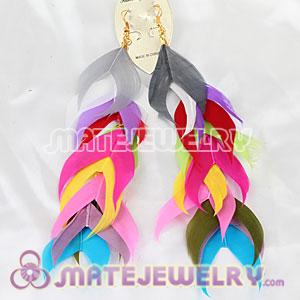And what do you know, American Apparel indeed is in turnaround mode, its stock trading for less than $2 a share, as the company revamps its operations and sales strategy. They have lost money in the last seven quarters or so, but have had good sales lately and expect to make a profit in fourth quarter of this year. What's more, investor extraordinaire George Soros last year gave the company an $80 million cash infusion, so confident is he about its prospects. So I took a few dollars from my savings and bought some shares.
Last night, I decided to check American Apparel's website, to get a feel if their website seems to be up to the turnaround task, although I don't know exactly which criteria I was going to use to evaluate that. In any case, I start clicking to look at their clothing, and I run into this:

I click some more, and with few exceptions, the images that followed were equally suggestive. All their models are girls no older than high school, sticking their butts out, lifting their skirts, lowering their bikini bottoms, lifting their shirts, lying down in come-hither poses, you get the idea. (If online porn is your thing, all you have to do is go to the AA website.)
As I started to stay rational in my reaction to the images, I decided to look at the website's images for men's clothing, which, for the most part, look something like this:

Slightly different approach, don't you think? Doesn't he look like a clean cut guy who still has some growing up to do, while he explores science and technology and sports and age-appropriate social interaction? And aren't we just happy to let him do so?
But what are the ads saying to his female classmates?
As I read more about American Apparel, it turns out that its racy ads have repeatedly been criticized by the British Advertising Authority, for, essentially, using young women in pornographic poses. Here in the U.S.? Nothing. Not an ounce of criticism, never mind outrage.
And as I ponder the whys and wherefores of how and why I am shocked and offended and outraged, I come accross an article a friend of mine posted on her Facebook page. (Thank you Maria Aurora.) The article (link below) delved into how our society has come to play so loosely with girls' ages, when it comes to sexuality. http://www.salon.com/2013/09/04/the_six_ways_we_talk_about_a_teenage_girls_age/
That women are exploited as sexual symbols is as old as Moses, so it doesn't exactly qualify as a trend. What does constitute a disturbing trend, especially in this country in which we boast of advancement and freedom, is at the much younger age this exploitation of girls is now beginning.
The American Psychological Association has taken notice, and in 2007 it commissioned a task force to look into the consequences of this trend. None of them are good. Surprise, surprise. To learn more about the APA's work on this, click here. http://www.apa.org/pi/women/programs/girls/index.aspx
To be sure, smart girls and girls who are allowed, encouraged and nurtured to be the full persons that they are, can see through the message and know that those images have nothing to do with who they are and who they will become. Certainly, the girls in the panel shown in the video below are all smarter and more insightful than top management at American Apparel. It is just a pity that they have to constantly wade through the barrage of degrading messages, just because they happen to girls.
http://www.youtube.com/watch?feature=player_embedded&v=B2PddIma3LQ
As to American Apparel stock, of course I'm selling it, ridding myself of my tiny ownership of the company with a big teenage "eeww".
Wish George Soros would do the same.

 Unpretentious Leonard, seemingly out of thin air, produces beautiful holograms before her eyes. Penny falls quiet, genuinely wowed, and says tenderly: "Sometimes I forget how smart you really are." Leonard beams and seems to grow six inches taller.
Unpretentious Leonard, seemingly out of thin air, produces beautiful holograms before her eyes. Penny falls quiet, genuinely wowed, and says tenderly: "Sometimes I forget how smart you really are." Leonard beams and seems to grow six inches taller. 



